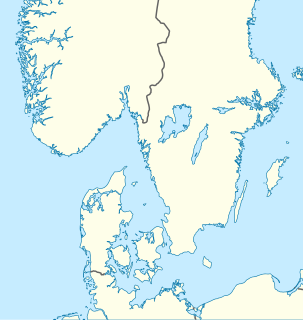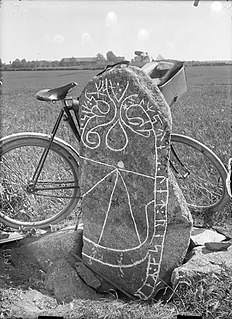
The Hillersjö stone, listed in the Rundata catalog as U 29 and located at Hillersjö, which is about four kilometers north of Stenhamra on Färingsö, is a runic Younger Futhark inscription that tells, in Old Norse, the tragic real life family saga of Gerlög and her daughter Inga. It is the longest runic inscription in Uppland and the second longest one in Sweden after the Rök Runestone.

The Snottsta and Vreta stones are individual runestones known as U 329, U 330, U 331 and U 332. They are found on the homesteads of Snottsta and Vreta, and they tell in Old Norse with the younger futhark about the family story of Gerlög and Inga in 11th century Uppland, Sweden, together with the Hillersjö stone and the runestone U 20/21.

The Hargs bro runic inscriptions, or U 309, U 310 and U 311, are 11th century Younger Futhark inscriptions in Old Norse on bedrock in Skånela Parish, Uppland, Sweden.

The Jarlabanke Runestones is the name of about 20 runestones written in Old Norse with the Younger Futhark rune script in the 11th century, in Uppland, Sweden.

Fot was a runemaster who flourished in mid-11th century Sweden. He is sometimes known as Foto.

The Granby Runestone, designated as U 337 under the Rundata catalog, is one of the longest Viking Age runic inscriptions located in Uppland, Sweden.

The England runestones is a group of about 30 runestones in Sweden which refer to Viking Age voyages to England. They constitute one of the largest groups of runestones that mention voyages to other countries, and they are comparable in number only to the approximately 30 Greece Runestones and the 26 Ingvar Runestones, of which the latter refer to a Viking expedition to the Middle East. They were engraved in Old Norse with the Younger Futhark.

The Gällsta Runestones from the 11th century commemorate four generations of the same family in Viking Age Sweden. There are three runestones and a raised stone which is only inscribed with a cross. The runestones are located at the northern outskirts of Stockholm, just northwest of the lake Vallentunasjön, around which is found the world's greatest concentration of runestones. All the Gällsta Runestones are attributed to Öpir, the most productive of all the old runemasters.

The Manx runestones were made by the Norse population on the Isle of Man during the Viking Age, mostly in the 10th century. Despite its small size, the Isle of Man stands out with many Viking Age runestones, in 1983 numbering as many as 26 surviving stones, which can be compared to 33 in all of Norway. So many of them may appear on the Isle of Man because of the merging of the immigrant Norse runestone tradition with the local Celtic tradition of raising high crosses.

Uppland Runic Inscription 1034 or U 1034 is the Rundata catalog number for a runic inscription on a runestone located at the Tensta Church, which is three kilometers northwest of Vattholma, Uppsala County, Sweden, and in the historic province of Uppland, that was carved in the late 11th or early 12th century. While the tradition of carving inscriptions into boulders began in the 4th century and lasted into the 12th century, most runestones date from the late Viking Age.

This runic inscription, designated as U 448 in the Rundata catalog, is on a Viking Age memorial runestone located in Harg, which is about 4 kilometers north of Märsta, Stockholm County, Sweden, which was in the historic province of Uppland.

This runic inscription, designated as U Fv1948;168 in the Rundata catalog, is on a Viking Age memorial runestone to two sons that is located in Alsike, Uppsala County, Sweden, which is in the historic province of Uppland.

This runic inscription, designated as U Fv1976;104 in the Rundata catalog, is on a Viking Age memorial runestone that is located at the Uppsala Cathedral, Uppland, Sweden.
The Lilla Vilunda runestones are three Viking Age memorial runestones that were erected by members of the same family and which are located at Lilla Vilunda in Upplands Väsby, Stockholm County, Sweden, and in the historic province of Uppland.

Uppland Runic Inscription 80 or U 80 is the Rundata catalog listing for a Viking Age memorial runic inscription that is located in Sundby, which is in Solna Municipality, Stockholm County, Sweden, and in the historic province of Uppland.

Uppland Runic Inscription 181 or U 181 is the Rundata catalog number for a Viking Age memorial runestone located at Össeby-Garn, which is about one kilometer east of Karby, Uppsala County, Sweden.

The Kyrkogården Runestones are three Viking Age memorial runestones located at the cemetery of St. Mary's Church in Sigtuna, Stockholm County, Sweden, in the historic province of Uppland. One of the runic inscriptions documents the existence of a Viking Age mercantile guild in Sweden.

Uppland Runic Inscription Fv1953;263 or U Fv1953;263 is the Rundata catalog listing for a Viking Age memorial runestone that was discovered at Helenelund, which is in Sollentuna, Stockholm County, Sweden, which was in the historic province of Uppland.

Uppland Runic Inscription 541 or U 541 is the Rundata catalog listing for a Viking Age memorial runestone which is located at the Husby-Sjuhundra church, which is five kilometers west of Norrtälje, Stockholm County, Sweden, and in the historic province of Uppland. The inscription is signed by the runemaster Öpir.

























